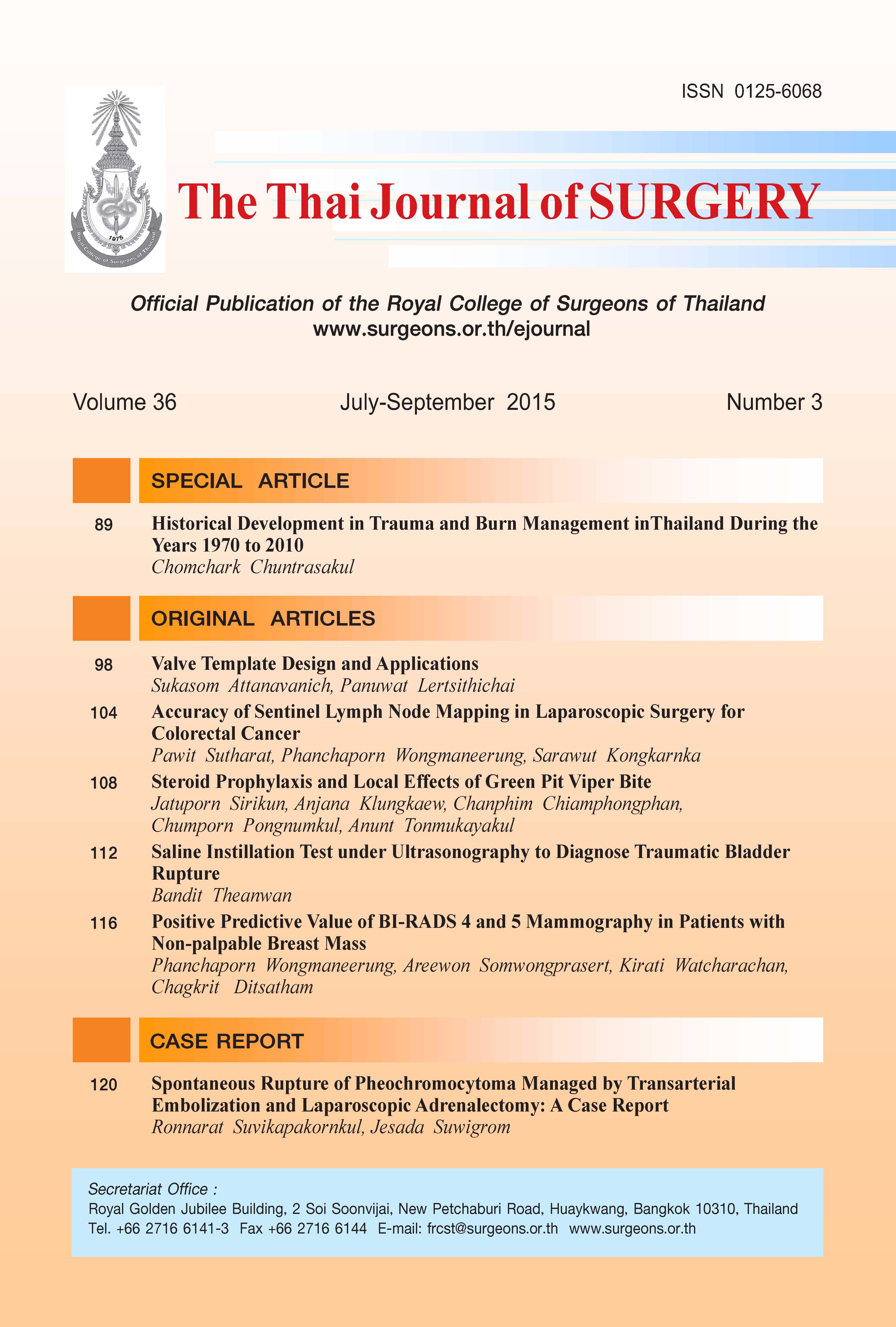Steroid Prophylaxis and Local Effects of Green Pit Viper Bite
Keywords:
Snake bite, green pit viper, steroid, local effectsAbstract
Background and Objective: The recommendation of using prophylactic steroids to decrease local effects ofvenomous snake bite is controversial. There is no scientific data to support the benefit of this recommendation. We
conducted a randomized controlled trial to determine the benefits of steroid prophylaxis on the local effects of
venomous snake bites.
Material and Method: A double blind randomized controlled trial was performed during March 2004 and
October 2004. Patients were randomized into 2 groups: the prednisolone (0.5mg/kg single dose) group (n=17) and
the placebo group (n=17). The inclusion criteria included: patients bitten by the green pit viper and could identify
the snake; bite time within 6 hours; no previous wound manipulation; and age over 12 years. The exclusion criteria
included: evidence of abnormal bleeding (systemic bleeding, or minor bleeding such as petechial hemorrhage, or
ecchymosis) with abnormal venous clotting times (> 30 minutes). The outcomes compared included swelling scores,
pain scores, presence of skin blebs, skin necrosis, itching and numbness. All outcomes were compared on initial
presentation, and 24 hours, 48 hours, 72 hours, and 7 days after presentation. Statistical analysis was performed using
the SPSS® software version 10.0. P-values less than 0.05 were considered statistically significant.
Results: 34 patients (18 male and 16 female) were bitten by the green pit viper between March 2004 and
October 2004. There were no significant (P> 0.05) differences in the swelling scores, pain scores, presence of skin
blebs, skin necrosis, itching, and numbness between both groups.
Conclusion: No benefit of prophylactic steroids for decreasing local effects of green pit viper bite could be
demonstrated in the present study.
References
preventive measures against snake bites. J Med Assoc Thai
1997;80:547-56.
2. Rojnuckarin P, et al., Prognostic factors of green pit viper
bites. Am J Trop Med Hygiene 1998;58:22-5.
3. Visudhiphan S, et al. Dark green pit viper (Trimeresurus
popeorum) bite: clinical and serial coagulation profiles in 51
cases. Am J Trop Med Hygiene 1989;41:570-5.
4. Ben Abraham R, et al. Snakebite poisoning in children–a call
for unified clinical guidelines. Eur J Emerg Med 2001;8:189-
92.
5. Blanco Bruned, JL, et al. Poisoning by viper bites in children.
Ann Esp Pediatr 1993;38:119-22.
6. Gerber JD, Adendorff HP. Boomslang (Dispholidus typus)
bite: case report. S Afr Med J 1980;57:710-1.
7. Grace TG, Omer GE. The management of upper extremity
pit viper wounds. J Hand Surg [Am] 1980;5:168-77.
8. Kleber JJ, Zilker T. Adder bites in humans. Tierarztl Prax Ausg
K Klientiere Heimtiere 1998;26:95-100.
9. Kurecki BA, Brownlee HJ. Venomous snakebites in the United
States. J Fam Pract 1987;25:386-92.
10. Mahasandana S, Jintakune P. The species of green pit viper
in Bangkok. Southeast Asian J Trop Med Public Health 1990;
21:225-30.
11. Gunnels D, Gunnels MD. Snakebite poisoning: treatment
myths and facts. J Emerg Nurs 2003;29:80-2.
Downloads
Published
How to Cite
Issue
Section
License
Articles must be contributed solely to The Thai Journal of Surgery and when published become the property of the Royal College of Surgeons of Thailand. The Royal College of Surgeons of Thailand reserves copyright on all published materials and such materials may not be reproduced in any form without the written permission.



